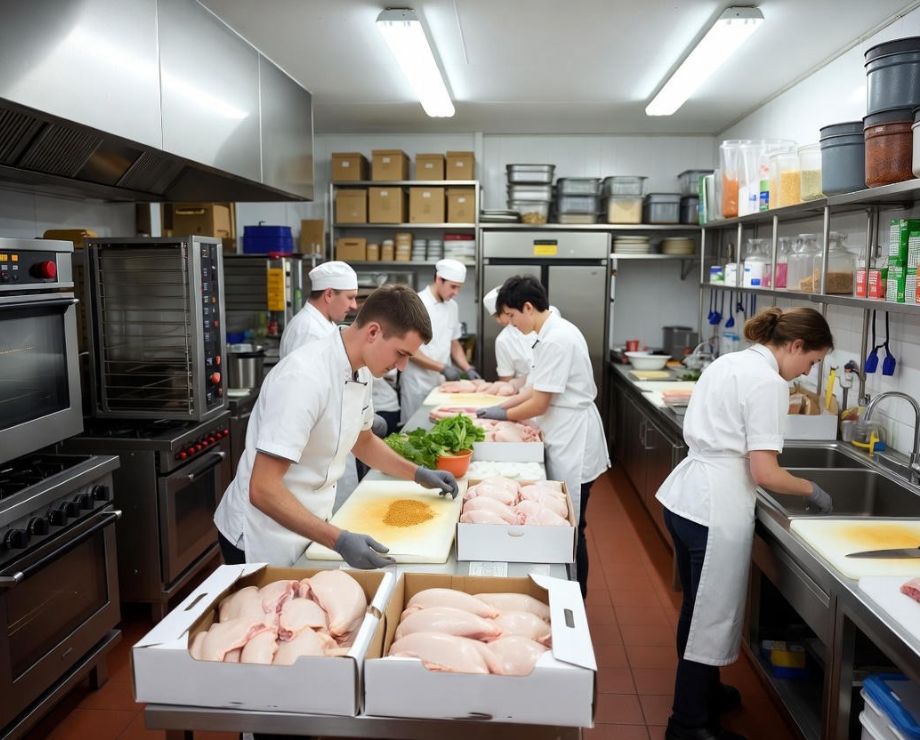Running a busy restaurant or takeaway kitchen means every minute and every kilogram of chicken counts.
When you’re managing large-scale fresh poultry orders, efficiency and hygiene aren’t just operational goals; they directly affect food safety, flavour, and profit margins.
At Magna Foodservice, we supply thousands of kilograms of fresh halal poultry to professional kitchens each week. Here’s how to make the most of your deliveries from receiving and storing to prepping and serving with less waste and maximum freshness.
1. Prepare Your Kitchen for Large Deliveries
Before your next 10 kg or multi-carton fresh chicken delivery arrives, please make sure your kitchen is ready to handle it safely and efficiently.
Quick Checklist:
- Clear chilled storage space: Poultry must go straight into refrigerated storage at 0-4 °C.
- Clean and sanitise work surfaces, containers, and trays.
- Assign receiving staff trained in food-handling and record-keeping.
By preparing before delivery, you minimise temperature fluctuations and ensure the product maintains peak quality, something we prioritise in our Fresh Halal Poultry range.
2. Inspect and Receive Fresh Chicken the Right Way
When receiving bulk poultry orders:
- Check delivery temperature (must read 0-4 °C).
- Verify vacuum-seal integrity. There should be no leaks or excess liquid.
- Cross-check batch labels, halal certification, and best-before dates.
- Rotate stock immediately using the FIFO (First In, First Out) method.
At Magna, we label every batch clearly for traceability, so kitchens can manage stock rotation easily and confidently.
3. Organise Chilled Storage Efficiently
Proper organisation in cold storage can make or break your workflow.
Best Practices:
- Store poultry on the bottom shelves to prevent cross-contamination.
- Keep cartons elevated on racks to allow airflow.
- Use separate containers for different cuts (fillets, thighs, wings).
- Record in/out times for each batch in your HACCP log.
Magna’s vacuum-sealed packaging keeps chicken fresher for longer, but efficient storage still matters to maintain texture and safety.
Need a guide to the right cuts for your menu? Check out our post on Fresh Chicken Cut Guide.
4. Streamline Prep Stations for Speed and Safety
Large-scale prep doesn’t have to mean chaos.
Create designated prep zones for poultry, with:
- Colour-coded chopping boards and utensils.
- Sanitiser and gloves within reach.
- A dedicated sink for washing tools and surfaces only.
This setup reduces cross-contamination risks and keeps staff focused on accuracy and speed.
5. Portion, Marinate, and Label in Batches
Time efficiency is key in bulk prep.
- Portion fillets or wings by weight (e.g. 200 g servings).
- Marinate in sealed, labelled containers by date and time.
- Store prepped chicken back in the chiller immediately.
Batch labelling prevents confusion during rush hours and ensures freshness across shifts.
6. Minimise Waste and Maximise Yield
Wastage eats into profits literally.
Tips to Reduce Waste:
- Use trimmings for broths, stocks, or staff meals.
- Plan prep quantities according to expected footfall.
- Monitor expiry dates closely; vacuum-sealed packs help extend usability.
- Work with suppliers (like Magna) who deliver consistent portion sizes and reliable quality.
Read more on Reducing Carbon Footprint in Fresh Poultry Supply for sustainable, waste-reduction insights.
7. Schedule Deliveries for Smooth Workflow
Magna offers flexible delivery schedules, helping kitchens avoid over-stocking or running out mid-service.
By spreading your orders (e.g. two to three deliveries weekly), you ensure continuous freshness and a balanced fridge load.
Efficient delivery timing also improves:
- Stock rotation control
- Prep scheduling
- Space management
8. Build Staff Training Around Safe Handling
Even the best poultry supply needs knowledgeable hands.
Invest in short, practical training sessions to reinforce:
- Correct temperature checks.
- Hygiene and glove use.
- Stock rotation discipline.
- Handling procedures for vacuum-sealed packaging.
Staff consistency means less waste, better hygiene, and smoother operations.

